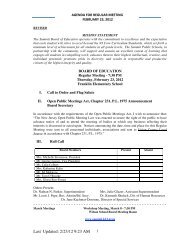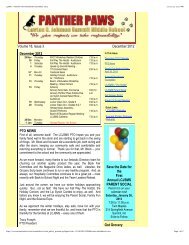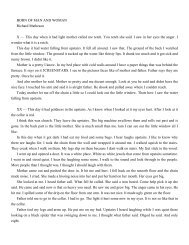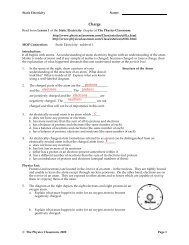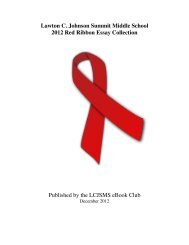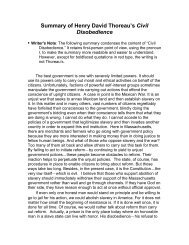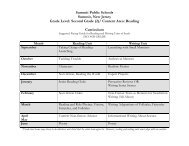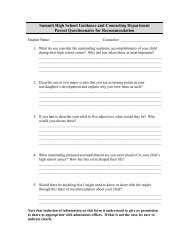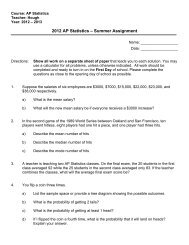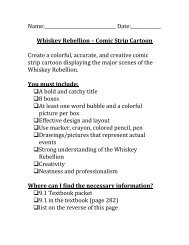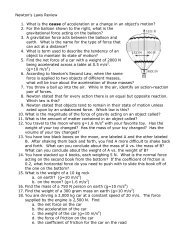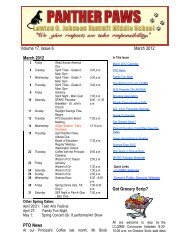Marshmallows
Marshmallows
Marshmallows
You also want an ePaper? Increase the reach of your titles
YUMPU automatically turns print PDFs into web optimized ePapers that Google loves.
<strong>Marshmallows</strong><br />
by Jim Cornish<br />
(1) Toasting<br />
marshmallows over<br />
a campfire is a<br />
lasting memory of<br />
childhood. But<br />
while enjoying this<br />
gooey treat, people rarely stop to<br />
think about how marshmallows got<br />
their name or who made them first.<br />
After all, toasting them golden brown or<br />
turning them into flaming torches is much<br />
more fun.<br />
(2) <strong>Marshmallows</strong> have a long and<br />
interesting history. The ancient Egyptians<br />
first developed the sweet some 4000 years<br />
ago using the mallow plant that grew wild in<br />
the marshes along the Nile River, hence<br />
their name “marsh mallows.” They used the<br />
white, sweet sap from marsh mallow roots to<br />
thicken a mixture of nuts and honey. It<br />
wasn’t a treat for everyone though. It was<br />
considered a food for the gods and severed<br />
only to the pharaohs and members of his<br />
royal family. What the first marshmallows<br />
looked like, no one really knows.<br />
(3) The ingredients and<br />
methods used to make<br />
marshmallows have<br />
changed greatly over the<br />
centuries. In the early to<br />
mid-1800's French candy<br />
store owners whipped egg whites, sugar<br />
and mallow sap into a fluffy meringue. They<br />
placed the mixture in cylindrical molds,<br />
giving the marshmallows their familiar<br />
shape. This rather time-consuming process<br />
produced marshmallows so costly only the<br />
wealthy could afford them.<br />
(4) By the late 1800's a new recipe and a<br />
new method of making marshmallows<br />
emerged. Cornstarch and gelatin replaced<br />
the mallow sap and machines replaced hand<br />
mixing. Once hardened and placed in tins,<br />
the marshmallows sold as penny candy and<br />
became a treat everyone could afford.<br />
(5) In 1954, American Alex Doumakes, the<br />
son of a Greek immigrant candy maker,<br />
developed the marshmallow recipe and<br />
manufacturing process in use today. He
combined corn syrup or sugar, gelatin,<br />
gum arabic and flavoring for his<br />
marshmallow recipe. Instead of making<br />
them by hand, he squeezed the mixture<br />
from long tubes to create long spongy<br />
marshmallow ropes. After a dusting them<br />
with non-stick corn-starch, the ropes<br />
were sliced into the bite-sized chunks<br />
familiar today. The whole process<br />
slashed production time from 24 hours to<br />
just 6o minutes.<br />
(6) You might be surprised to learn that<br />
marshmallows were once used as<br />
medication. The Romans and Greeks, as<br />
well as nineteenth century doctors,<br />
hardened marshmallows to looked like<br />
lozenges and prescribed them to soothe<br />
sore throats, to suppress coughs, to cure<br />
ulcers and to treat toothaches and insect<br />
bites. While marshmallows are no longer<br />
used as medication, the mallow’s roots,<br />
leaves and flowers are used to make a<br />
wide variety of pharmaceuticals and<br />
herbal remedies.<br />
(7) Today, eaten straight from the bag,<br />
used to make cookies or toasted over a<br />
campfire, marshmallows have proven to<br />
be a popular year-round snack.<br />
Marshmallow<br />
Fun Facts<br />
• Americans buy 90 million pounds of marshmallows each<br />
year, about the same weight as 1,286 gray whales.<br />
• The marshmallow capital of the world is in Ligonier,<br />
Noble County, Indiana.<br />
• Each summer more than 50% of all marshmallows sold are<br />
toasted over a fire<br />
• Americans spend nearly $125 million dollars on<br />
marshmallows each year.<br />
• During World War II marshmallows were used as a<br />
substitute for rationed sugar.<br />
• The largest marshmallow treat ever made weighed 1,600<br />
lbs and used 20,000 toasted marshmallows and 7,000<br />
chocolate bars. The record was set on May 23, 2003.<br />
• When the Olympic flame, hand-carried from Greece to<br />
Canada in 1988, was left within easy reach of people along<br />
the parade route, they roasted marshmallows over it.<br />
• In one year, the Kidd & Company’s marshmallow factory<br />
churns out enough marshmallows to circle the globe nearly<br />
twice.<br />
• marshmallows today are almost 100 percent sugar and are<br />
injected with air to make them fluffy.<br />
Sources:<br />
www.candyusa.org/Candy/marshmallows.asp<br />
www.dountoothers.org/marshmellows12-05.html
Reading:<br />
Main Idea<br />
1. The main idea of this passage is:<br />
a. marshmallows are fun to toast and eat<br />
b. the history of marshmallows<br />
c. marshmallows are really soft candy<br />
d. many people like to eat marshmallows<br />
2. Topic Sentence<br />
a. What is the topic sentence for paragraphs two and three<br />
Reading:<br />
Vocabulary<br />
1. What two words in paragraph five mean “cut”<br />
2. What words are used throughout the passage to describe marshmallows<br />
3. Match the following definitions with a word in the paragraph indicated in brackets.<br />
a. (1) seldom<br />
b. (2) very old<br />
c. (3 ) easily recognized<br />
d. (4) able to buy<br />
e. (5) to sprinkle lightly<br />
f. (6) medicine in a candy-like form<br />
g. (7) something used or someone liked by many<br />
Visual Literacy<br />
1. How are today’s marshmallows different from the ones made by the ancient Egyptians<br />
Organize your answer in a T-chart.
Reading Comprehension: Literal<br />
1. How were marshmallows used as medicine<br />
2. What role(s) have the following ingredients played in the making of marshmallows<br />
a. sugar<br />
b. mallow root sap<br />
c. corn starch<br />
3. How did marshmallows get their name<br />
Reading Comprehension: Inferential<br />
1. Why did only the wealthy eat marshmallows in centuries past<br />
Your Opinion<br />
1. Why do you think toasting marshmallows is a favourite memory of childhood<br />
Short and Snappy<br />
1. What percentage of marshmallows made each year are toasted<br />
2. In what year B.C. were Egyptians making their version of marshmallows<br />
3. How much money do Americans spend on marshmallows each year<br />
4. The number of hours saved in producing marshmallows in 1954<br />
5. During which war were marshmallows used as a substitute for sugar



